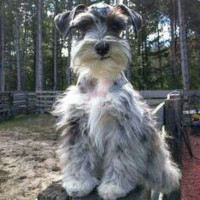Appearance of the Giant Schnauzer Chin
|
| The Giant Schnauzer Chin is a specific cross between a Japanese Spaniel and a Giant Schnauzer. Common colors are probably black, salt and pepper, white and red, while the coat can be wiry, hard and dense like the Giant Schnauzer or silky and long like the Japanese Spaniel. The two parent breeds are very different, the Giant Schnauzer having a broad, muscular body with a distinct beard and eyebrows. They have oval-shaped eyes that are dark brown and sunken, and tails that are generally docked. The Japanese Spaniel is also quite robust but is much smaller than a Giant Schnauzer, with a short face and large, expressive eyes. They have feathered ears and feathers on the back of the front legs. The tail is feathery. Your hybrid will adopt the most dominant features of the parent, although this hybrid is usually seen with the characteristic eyebrows and beard. |
Temperament of the Giant Schnauzer Chin
|
| A Giant Schnauzer Chin is likely to adopt many traits from their parent breeds and is therefore likely to make an excellent pet, preferably in a home with older children. The Giant Schnauzer is very protective of its family and wary of strangers, but is a playful and energetic dog. They are very intelligent dogs, but will need early socialization as they can be aggressive with other dogs and cats. A Japanese Spaniel is a little more difficult to train, especially when it comes to training. They love being with people and are playful, happy dogs. They're a bit like cats in that they love to climb and groom themselves. Japanese Spaniels must be kept on a leash when outdoors, as they hunt other animals. They don't need much exercise and don't like to be left alone for too long. Your hybrid will be a wonderful combination of both, thriving with consistent but patient training. Guidance is welcome and necessary for your hybrid to understand its place in the household. |
Needs and activities of the Giant Schnauzer Chin
|
| Depending on the parent breed, the Giant Schnauzer Chin takes after the most, this will depend on the amount of exercise required. A Giant Schnauzer needs at least an hour of intense exercise every day, and can become very destructive if it doesn't get enough. They love to run or go for long walks and, like Japanese Spaniels, must be kept on a leash to avoid chasing other dogs. Japanese Spaniels need very little exercise and are happy as long as their owner is nearby. They do well in an apartment, unlike the Giant Schnauzer, which needs a garden to play in, even though it should always live indoors. Both parent breeds tolerate cold more than heat, so don't walk them when it's too hot. |
Maintenance of the Giant Schnauzer Chin
|
| Like the two parent breeds, the Giant Schnauzer Chin will probably need moderate maintenance. The Giant Schnauzer is hypoallergenic, but the Japanese Spaniel is not, so coat care will depend on which your pet takes more. The Giant Schnauzer needs trimming around the eyebrows, beard and body, but the Japanese Spaniel doesn't need trimming, except sometimes around the feet. Your pet won't need much grooming to keep it looking good, and won't shed much either. Like parent breeds, your pet is unlikely to need brushing more than once a week. Try to brush your dog's teeth every day to avoid any dental problems, and check the ears for dirt or wax. If necessary, wipe them gently with damp absorbent cotton. Nails should also be checked to see if they need trimming or grooming. |









 English (United Kingdom)
English (United Kingdom)